Among the easiest plants to care for, Sempervivum Grey Lady demonstrates an exceptional tolerance to heat, drought, and neglect, showcasing its resilience effortlessly. This mid-sized perennial succulent variety presents flattened, ovate-shaped leaves arranged in rosettes, exhibiting pointed tips and fuzzy leaf margins. The leaf surfaces are smooth on both the front and back, while in winter or under significant temperature variations, the foliage may adopt a wine-red hue, appearing glossy and thickened.
As with other Sempervivum varieties, Grey Lady thrives as a low-maintenance succulent. Initially sprouting green, the lateral shoots gradually transition to a wine-red shade, while during the summer dormancy period, the plant's coloration shifts to a grayish-red or greenish hue. Over time, the plant undergoes gradual clustering, forming a strikingly beautiful display.
How to Care for Sempervivum Grey Lady?
Sun and Temperature

Image Credit: happydiyhome.com
Sempervivum Grey Lady thrives in full sun but can benefit from some afternoon shade in summer. It actively grows in spring, fall even in winter. Full sun can be good. Especially when you put them indoor in winter, put them at south-facing window. During summer, Grey Lady goes dormancy. It's sensitive to high temperatures and prone to rot during summer, emphasizing the need for proper air circulation in cultivation. Indoor growth isn't ideal as it often lacks the preferred sunlight, causing stretching towards the nearest light source. Sempervivum Grey Lady is cold-hardy, thriving in temperatures between 82°F to 53°F. It can safely overwinter above 35°F.
Watering
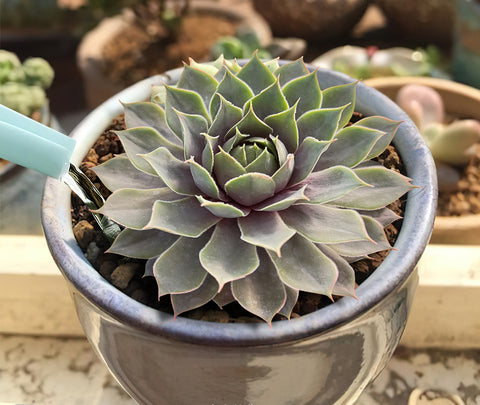
Generally, water Sempervivum Grey Lady 3 to 4 times per month. When watering, aim to water directly into the soil with only a small amount at the pot's edge. Gradually reduce watering if the winter temperature falls below 37°F, keeping the soil dry below freezing (32°F and lower). In well-ventilated areas, thorough watering is permissible; however, during summer and winter, try to avoid water accumulation at the center of the leaves. Sempervivums are quite drought-tolerant; you can wait until the lower leaves show signs of wrinkling before watering. Overwatering may conversely lead to rot and etiolation.
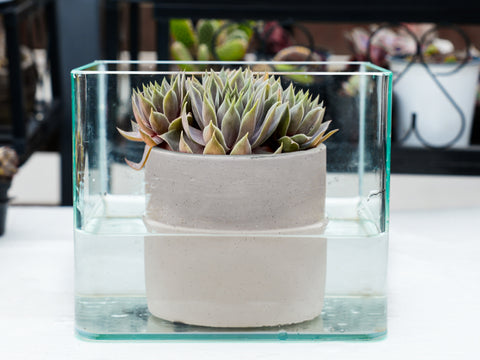
It's worth noting that Sempervivum plants tend to produce offsets at their base, making top watering challenging as it may not reach the soil. Therefore, when your Sempervivum Grey Lady is filled with offsets, we recommend using the bottom watering method. Firstly, ensure there's a drainage hole at the bottom of the container. Then, place the plant in a larger container filled with 1/3 water and let it sit for 10-15 mins. Once you touch and feel the top soil is moist, take out the plant and finish the process. This method helps prevent ineffective watering and water accumulation on the leaves. You may wonder: when and how to bottom water succulents.
Soil

Image Credit: thehypertufagardener.com
Sempervivums are low-maintenance plants once established, but they will thrive best if the environmental conditions of their native mountain habitats are replicated. For soil, a mix of peat soil with granules at a ratio of 1: 1.5, emphasizing good aeration, is suitable. To isolate the plants from direct contact with the soil surface and enhance aeration, top dressing such as Maifanitum Stones with particle sizes ranging from 3 to 5 millimeters is commonly spread atop the soil.
Propagation
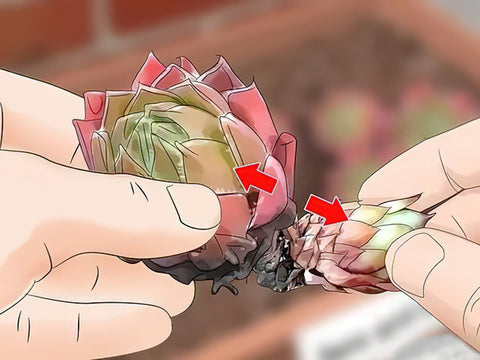
Image Credit: wikihow.com
Offset division and beheading are common ways to propagate Sempervivum Grey Lady. Generally, the division is used for propagation. In early spring, Grey Lady produces offsets or chicks from emerging branches. Offsets can be divided and potted in slightly moist soil, placed in a cool, ventilated area, and left to root. But please remember not to put them in moist soil until the wounds callus. If your Grey Lady has experienced elongation, much like our traditional perception of the Sempervivums, beheading for propagation is also a viable option.
Pests and Disease
Sempervivum Grey Lady generally shows strong disease resistance and is not significantly prone to pests but pays attention to Pseudococcus sometimes. When encountering diseases or pests, promptly remove affected leaves and roots, disposing of them properly to prevent the spread of disease. Additionally, maintain good indoor ventilation and avoid overly humid conditions. Spraying with a 50% Benomyl wettable powder or 70% Methyl Thiophanate wettable powder can be used for prevention. Apply the spray every 7-10 days for 2-3 consecutive times. You may wonder: a full guide on molds spots on succulents.
How to make Sempervivum thrive?
Fertilization
You don't need to provide Sempervivum with extra nutrients since they thrive in nutrient-deficient soil. However, if you believe your plant could use some feeding, consider these guidelines.
Timing and Frequency: It's recommended to fertilize approximately every 20 days. During winter, if nighttime temperatures remain above 41℉ and daytime temperatures are over 59℉, the plants can continue growing, allowing for regular watering and moderate fertilization.
Fertilizer Selection: Opt for diluted organic liquid fertilizer or a low-nitrogen, high-phosphorus, and potassium compound fertilizer. You can also choose a controlled-release fertilizer and feed it just once a year.
Application Method: Apply the fertilizer directly into the soil whenever possible, avoiding contact with the leaf center to prevent potential rot.
Avoid Turning Flat
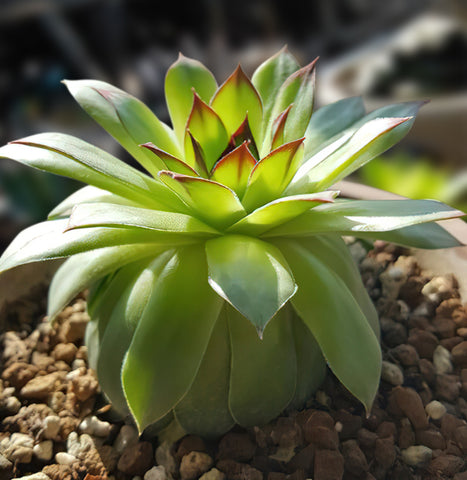
If your Sempervivum Grey Lady turns flat or goes leggy, it might be going through these challenges:
Insufficient sunlight: Sempervivum requires ample sunlight for photosynthesis. Inadequate light can hinder plant growth and cause the leaves to spread out.
Overwatering: Sempervivum Grey Lady is quite drought-tolerant. Overwatering may cause root rot, leading to the leaves becoming flattened.
Poor potting soil drainage: Inadequate soil drainage can cause water accumulation, leading to root rot and leaf spreading in Sempervivum Grey Lady.
Improper fertilization: Over-fertilization can cause root burn, leading to loss of vitality. It can also cause flat or leggy issues.
To avoid turning flat, you need to follow these:
Enough sunlight exposure: Ensure Sempervivum Grey Lady receives adequate sunlight daily. Place it near a window for sufficient light exposure if it's planted indoor.
Water control: Avoid frequent watering; ensure the soil is dry before watering to prevent overgrowth. The soil should have good drainage and aeration to prevent root rot caused by water accumulation.
Ventilation: Good airflow benefits the growth of Grey Lady and helps prevent diseases. Place the plant in a well-ventilated area to avoid a damp environment.
Fertilization management: Fertilize sparingly with a low-nitrogen, high-phosphorus, potassium compound fertilizer once a month at most.
Beheading: If your Sempervivum Grey Lady has elongated or turned flat, the lower leaves won't return to their original compact form. You can opt for beheading propagation to cultivate a new plant. This way, you'll obtain a new, healthy plant. Then, follow the principles mentioned above to maintain your new Grey Lady and prevent further etiolation.
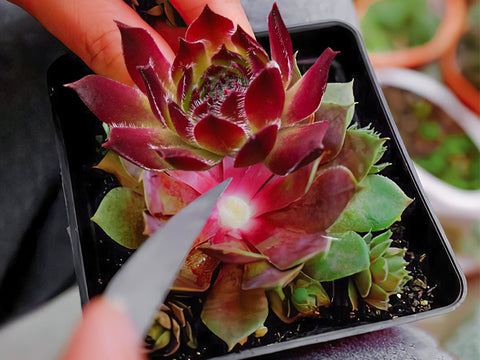
Conclusion
The ideal environment for Sempervivum Grey Lady is in high-altitude regions with abundant rain, strong winds, poor soil, intense UV exposure, and cool weather – much like its natural mountainous habitat. Like its family members, it is a low-maintenance variety. I believe this blog can help you cultivate Sempervivum Grey Lady more healthily, and soon, it will grow many chick babies for you.

























